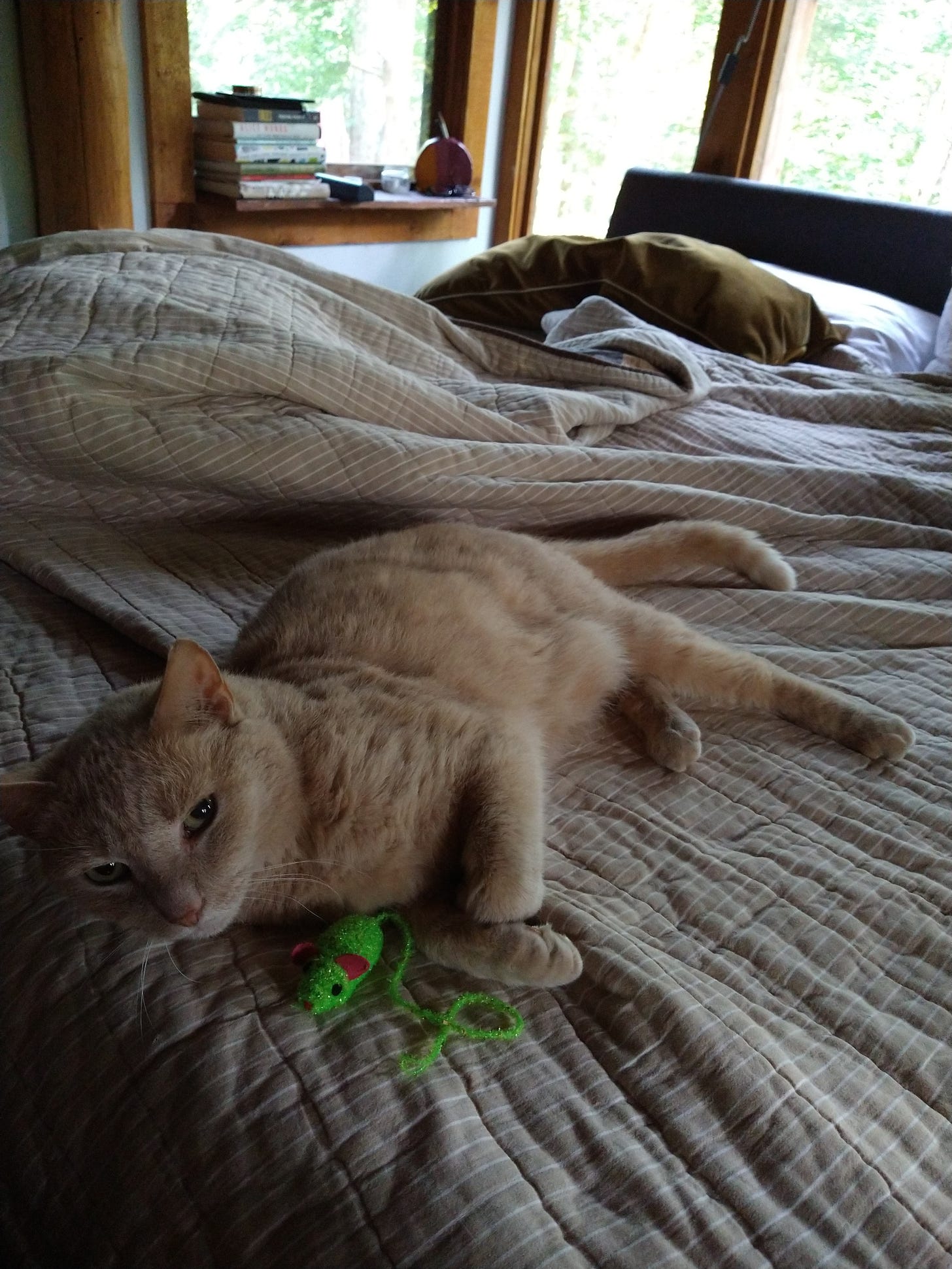Have you ever heard an eerie howling at night? With maybe some barks and yips? Like this?
It might have been a coyote—or a pack of coyotes.
We hear them in the distance sometimes, but on Saturday they were howling and barking and yipping all through the night, and they were closer than usual. We realized that even though we’ve written about owls and bats and snakes and beavers and bobcats, we’ve never written about coyotes! Like beavers and snakes, coyotes are cool animals and important members of the ecosystem. They’re also sometimes misunderstood.
Coyotes are actually not native to North Carolina—they’re from the western part of North America.
The name coyote comes from the Aztecs—they called the animal cóyotl, or trickster. Some Indigenous people thought of the coyote as God’s dog. In Native American mythology, the coyote is an important figure who, through his trickster ways, teaches humans about human nature and the best way to live with others.
Coyotes have lived in North America for more than a million years, and descended from golden jackals. They’re part of the canid family, which evolved in North America and includes wolves, jackals, and wild dogs. Those other canids spread to the rest of the world through land bridges, but coyotes never left!
The first white Americans to meeet the coyote were Lewis and Clark, who thought they’d seen a large fox. Then they shot one and named it the prairie wolf.
Mark Twain really hated coyotes! He didn’t like them because they scavenge dead animals, and wrote that “the meanest creatures despise him, and even the fleas would desert him for a velocipede.” In the early to mid 1900s, the American government’s Bureau of Biological Survey tried to exterminate both wolves and coyotes—and they almost succeeded with wolves. They tried shooting them, and eventually poisoned 6.5 million coyotes.
People still kill them, even shooting them from planes (!). Coyotes are feared because of their howling, and hated because they’ll also attack livestock and sometimes pets. But it’s important to realize that they live where they do (even cities and suburbs) because we’ve taken over their homes.
Here are some cool things Bea and Harriet learned about coexisting with the coyote:
Coyotes are also omnivores—they’ll eat berries and cactus fruit (in the desert), but they really love rodents. That’s one of the best things about them—as apex predators, they keep pesky rodent populations in check.
Hunting alone, they pounce on small prey, sort of like a cat:
In packs they can work together to attack larger animals, like deer. In our neighborhood on Saturday, we heard that three milk goats were chased from their pen by stray dogs, and so it’s possible that the coyotes we heard were closing in on them (!).
But coyotes are mostly afraid of humans. They also hunt at night, so you’re more likely to hear them than see them. If you do see one, here’s what to do:
-If it’s relatively far away, you don’t have to do anything. That coyote will probably stay away.
-But if it’s close, be calm and confident. Look it in the eye and back away slowly, but don’t turn your back and run because they could unlock their hunter instinct.
-If it’s approaching you, scare it away. Try to make yourself look bigger and stronger. Wave your arms and stomp your feet. Make noise any way you can. If you have a whistle or noisemaker, use it!
-But also remember: in the U.S. and Canada combined, there have only been two recorded instances of humans being killed by coyotes—ever! More people are killed every year by golf balls and flying champagne corks than are bitten by coyotes!
Coyotes are about the size of a border collie, between 30 and 50 pounds. Eastern coyotes are bigger than western ones because they’re a mix of coyote, wolf, and even dog. But they will sometimes attack small dogs and cats, so keep your dogs on a leash and try to keep your cats inside at night.
The best way to keep coyotes away from your home in general is to keep your yard clear of things that attract rodents: make sure to clean up spilled birdseed, don’t leave food scraps around, and pick up sticks and debris.
We’ve never seen a coyote on our wooded, steep land, even though we do have a compost heap. But this may be because we have the ultimate rodent cleaner-uper:
We hope those goats made it home!
If you want to read more about North American trickster mythology, including the coyote, we love Trickster: Native American Tales. We also love The Sea-Ringed World: Sacred Stories of the Americas.
We’re also interested in reading Coyote America: a Natural and Supernatural History by Dan Flores—some of what we learned about coyotes came from this fascinating National Geographic interview with him.
Do you hear coyotes where you live? Do you like the sounds, or do you find them creepy? Or maybe both?
Thanks to everyone for reading and sharing our posts about the public schools. We want you to know about a rally on June 21 at 10AM at the North Carolina State Capitol—Every Child NC is hosting a Rally for Every Child. There will be kid activities, balloons, music, and lunch at Edenton Street Methodist Church, and it looks like you can get a free T-shirt by signing up here.





Coyotes and badgers team up to hunt rodents together, as seen in this remarkable video in which a coyote gets a little antsy waiting for his slower badger friend:
https://youtu.be/mGyHlYPupHg
Very interesting post makes me root for the Coyote from roadrunner cartoons
Julius ! Your Mama be proud !